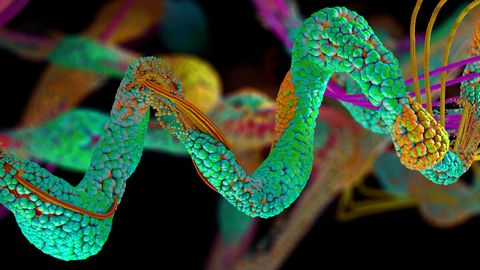Our Terms & Conditions | Our Privacy Policy
Exploring Proteoforms: Innovations in Proteomics Technology
Dr. Parag Mallick truly embodies the idea that humans can be multi-dimensional beings.
As an associate professor of radiology at Stanford University, his lab focuses on translating multiomic discovery into precision diagnostics. As the co-founder and chief scientist of Nautilus Biotechnology, he is working to develop a proteomics technology that he hopes will radically transform biomedicine. And, finally, as a professional circus performer, Mallick brings joy and curiosity to the lives of others through the art of close-up magic – a passion that no doubt adds a touch of wonder to his work as a scientist.
Don’t worry, you haven’t stumbled into the multiverse – Mallick is one of those rare individuals who masterfully juggles multiple passions at once.
At this year’s Human Proteome Organization (HUPO) world congress, Technology Networks had the pleasure of interviewing Mallick. We discussed the evolution of Nautilus from a “brainwave idea”, how its platform was developed and operates and Mallick’s vision for the future of proteomics.
Measuring the entire proteome in a single experiment
Mallick’s interest in proteins traces back to his childhood ambition of travelling into space. “Many people dream of becoming an astronaut when they’re four years old, but they grow out of it – I didn’t,” he said, adding that he found the concept of long-term spaceflight particularly intriguing. “One of my counsellors told me about the protein folding problem and how, if we could design proteins, we could help regulate the calcium cycle in a way that might allow humans to stay in space longer. I got very excited about these possibilities.”
Thus began Mallick’s path toward a career in proteomics.
“When I started my own lab in Los Angeles, first at UCLA and Cedars-Sinai and then at USC, we focused on clinical proteomics and systems medicine,” he said. “We asked questions about cancer: how it forms and develops, whether we can detect it earlier, and what it’s doing. I brought that work to Stanford, and our lab now explores where cancers come from, how they grow and how they evolve. We work on a few other diseases here and there, such as Alzheimer’s disease, but cancer dominates our focus.”
Continue reading below…
After working in the field for several years, advancing software and developing novel experimental workflows, Mallick decided that to take a true leap, he needed to take a step back: “I thought, what if we stopped optimizing existing instruments and workflows, took a blank piece of paper and imagined what we truly wanted?”
With this mindset, Mallick woke up one day with an idea for measuring the entire proteome in a single experiment.
“Once you have a thought like that, choice almost disappears from the equation – you have to do everything you can to bring that idea into the world,” he said.
He spent the weekend exploring this “brainwave” in greater depth, running simulations and trying to determine whether what he had conceived in his mind was possible in reality. “I emerged from that weekend thinking wow, this is even more doable than I first thought,” he said.
The brainwave marked the beginnings of Nautilus Biotechnology and the Nautilus Proteome Analysis Platform.
“The platform consists of several key components,” Mallick said. “First, we immobilize individual protein molecules from a sample onto a hyperdense, single-molecule protein array. We want to place each molecule in its own unique position on what is, effectively, a giant chessboard.”
This is not an easy feat. It required an innovative approach to overcome the limitations of traditional methods, such as limiting dilution, where a sample is heavily diluted and spread over a large area. “That approach doesn’t work very well if you want something that’s dense,” Mallick said, “because 90% of your space will be empty. If you’re scanning across your array and 90% of your space is empty, you’re wasting a lot of time. Also, limiting dilution depends upon a process called Poisson loading, so 50% of the time where there’s any molecule, there will be multiples.”
The Nautilus team’s solution was to create nanofabricated landing pads on the chess board and use intermediate molecules – DNA origami-based nanoparticles – that are the exact same size as the landing pads. “That means you can’t have two nanoparticles landing on the same spot,” Mallick explained.
Each nanoparticle resembles a brick with a flagpole sticking out of the top. This top portion of the nanoparticle has one chemical functionalization location, meaning it can only hold one protein molecule.
“We take the sample, glue the molecules to the intermediate nanoparticles and flow them over the flow cell. You have one protein molecule per nanoparticle and one nanoparticle per landing pad,” Mallick said.
Et voilà – you have a hyper dense single-molecule protein array that can hold billions of protein molecules.
Broadscale proteomics vs targeted proteoform studies
The Nautilus team envisions the platform having two research modalities: broadscale proteomics and targeted proteoform studies, Mallick explained.
Broadscale proteomics studies are often discovery-orientated – exploring the “unknown”. Researchers may want to identify proteins present in a sample or that are involved in specific molecular processes, for example.
“Our platform aims to achieve broadscale proteomics using Protein Identification by Short Epitope Mapping, or PrISM,” Mallick said.
Instead of using highly specific affinity reagents, the Nautilus platform uses multi-affinity probes that bind to short amino acid sequences (epitopes), which are flowed over the array across many independent cycles. In each cycle, high-resolution fluorescent imaging techniques are used to determine which probe has bound to a specific protein. By repeatedly probing each protein with various reagents targeting different epitopes, the platform builds a combinatorial binding profile for each molecule that is interpreted with machine learning to provide the protein’s identity.
“Somewhat surprisingly, we estimate that you’d only need 200–300 reagents to cover the entire proteome,” Mallick said.
In this context, Mallick sees Nautlius’ platform as a tool that researchers can use to ask and answer the biological questions that they are interested in.
Our conversation turned to targeted proteomics studies, or more specifically, proteoforms. Discussions on methods to identify and characterize proteoforms were aplenty at this year’s HUPO congress, highlighting the growing importance of this area in proteomics research.
What are proteoforms?
Proteoforms are variants of genetically encoded proteins. Researchers estimate that millions of theoretical proteoforms exist within the human proteome, adding yet another layer of complexity to its study and new opportunities for biological research.
“Proteoforms are very hard to measure,” Mallick said. Then, he smiled. “If only you had a way to look at things molecule by molecule and touch them over and over again.”
“Using our platform, you could apply an affinity reagent that’s looking for a phosphorylation site, and you can say this molecule was phosphorylated at location 217, and this at 205 and this one at 396 – this allows you to potentially interrogate patterns of multiple isoform variants and modifications on a molecule-by-molecule basis to quantify the molecular heterogeneity of the proteoform landscape,” Mallick said. “To our knowledge, this can’t be done at this level of complexity or sensitivity using any other technology.”
Continue reading below…

At HUPO, the Nautilus team presented data applying its platform to study proteoforms of Tau, a protein central to the pathophysiology of Alzheimer’s disease. “We were able to look at 2,000 proteoforms of Tau – and it’s likely that there are many more than that,” Mallick said.
“These pilot experiments are first of their kind and a step towards examining how the proteoform landscapes of Alzheimer’s and other neurodegenerative conditions may be impacted by changes in the abundance of key molecules. We envision this as a general template that will become a wide class of targeted proteoform analysis assays at higher resolution and scale than currently possible.”
What does the future of proteomics hold?
Nautilus is currently focused on identifying key partners, Mallick said: “HUPO has been really important for us, as it’s the first time that we’re sharing the proteoform data with the community, and it’s the first demonstration of the biological utility of the platform.”
“We are not a fully commercial company, but we are mature enough to begin some large-scale partnerships with leading researchers,” he continued, adding that the response so far has been incredibly positive.
Mallick is deeply passionate about how insights from the proteome could address major global challenges, including advancements in healthcare, food security and climate solutions. Looking to the future, he believes the field of proteomics is moving in three key directions that will help realize this potential:
“First, there’s a strong push for standardization to ensure data sets are uniformly collected and easily integrated. This is crucial for applying modern generative AI tools, which require high-quality, well-structured data,” he said. “Second, there’s an increasing diversification of platforms and methods. The choice of tools now depends on the specific question being addressed, similar to selecting the right book from a library. Techniques like the Coomassie gel and silver stain gel, for example, continue to coexist with newer methods, emphasizing the importance of choosing tools optimized for the task at hand.”
“Finally, I think we’re going to see an increased integration of proteomics data with data from other fields, such as transcriptomics and imaging,” he said.
In addition to advancing scientific research, Mallick exemplifies the importance of bringing your authentic self to the scientific environment, which can feel daunting. During his plenary talk at this year’s American Society for Mass Spectrometry, he included a magic show. “It could have gone terribly wrong, but instead, people really enjoyed it! They appreciated my unique perspective as both a scientist and a magician, and saw how this might influence my work,” he said.
“I believe embracing your individuality is crucial. It humanizes you and reminds others that you’re not just a scientist in a lab, but a person with a range of qualities.”
Images are for reference only.Images and contents gathered automatic from google or 3rd party sources.All rights on the images and contents are with their legal original owners.



Comments are closed.